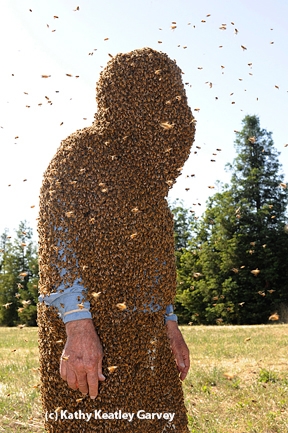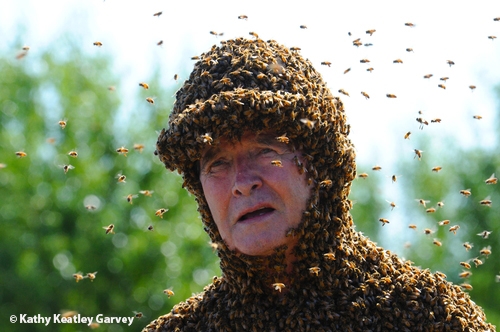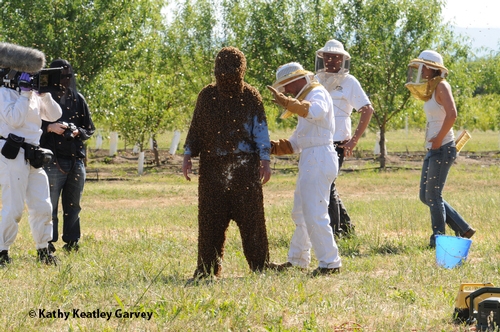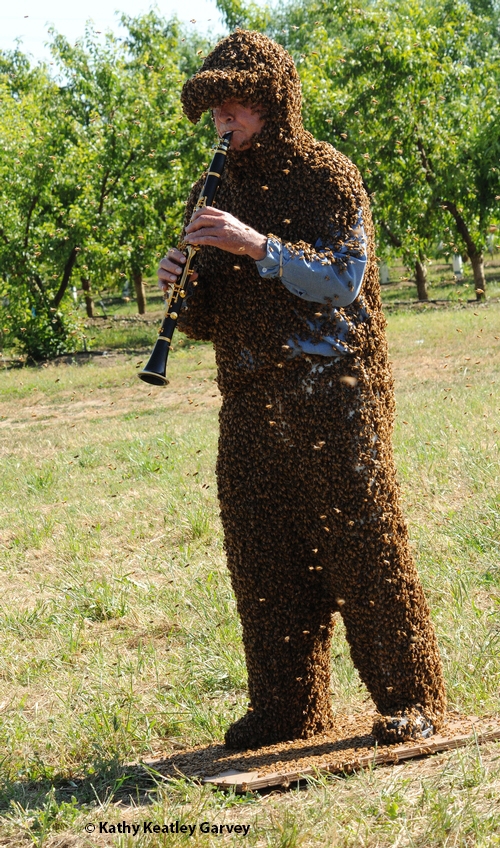- Author: Kathy Keatley Garvey

Gary, who received his doctorate in entomology (apiculture) from Cornell University, served as a professor at the University of California, Davis for 32 years, retiring in 1994.
Now 76, he's been a beekeeper for 62 years and a researcher for more than three decades. He's published more 100 peer-reviewed scientific papers and four book chapters.
His research on honey bees is well known. Among his accomplishments: he invented a magnetic retrieval capture/recapture system for studying the foraging activities of bees, documenting the distribution and flight range in the field.
He's also well known as a "bee wrangler"--he trains bees to perform action scenes in movies, television shows and commercials. His credits over the last 35 years include 18 films, including “Fried Green Tomatoes”; more than 70 television shows, including the Johnny Carson and Jay Leno shows; six commercials, and hundreds of live Thriller Bee Shows in the Western states.
Gary will appear Thursday, Sept. 16 on a History Channel show wearing 75,000 bees. The show, part of Stan Lee's “Super Humans,” is scheduled to be broadcast at 10 p.m., Pacific Time (Channel 64 for local Comcast viewers in the Davis area).
Host-presenter Daniel Browning Smith has billed him as “the human bee hive” and will explore bee behavior and the science behind the bees.
A crew from England filmed Gary in mid-May at the Harry H. Laidlaw Jr. Honey Bee Research Facility at UC Davis; at Rick Schubert's Bee Happy Apiaries in Vacaville-Winters; and then in a UC Davis open field where the 75,000 bees clustered his entire body.
“That's about 20 pounds, depending upon how much honey or sugar syrup they have consumed,” Gary said. “A hungry bee weighs approximately 90 mg and within a minute of active ingestion she can increase her weight to 150 mgs!”
We watched the entire process. Amazing. Simply amazing.
“Bees are not inclined to sting if they are well fed—happy and content—and are ‘under the influence' of powerful synthetic queen bee odors—pheromones—which tend to pacify them,” Gary said.
Bees are attracted to pheromones and they cluster on drops of pheromones he places on himself. While at UC Davis, he formulated a pheromone solution that is very effective in controlling bee behavior.
Gary (check out his website) once trained bees to fly into his mouth to collect food from a small sponge saturated with his patented artificial nectar. He holds the Guinness World record (109 bees inside his closed mouth for 10 seconds) for the stunt.
During his career, Norman Gary has worn many hats, including hobby beekeeper, commercial beekeeper, deputy apiary inspector in New York, honey bee research scientist and entomology professor, adult beekeeping education teacher, and author.
His book for beginning beekeepers, “The Honey Bee Hobbyist,” is to be published in early December by Bow Tie Press.
Don't be too surprised if he also writes one on bee wrangling.
The next generation can learn a lot from him.



- Author: Kathy Keatley Garvey

She's an insect virus researcher in professor Raul Andino's lab, UC San Francisco Department of Microbiology and Immunology, and she's the newly selected Häagen-Dazs Postdoctoral Fellow at UC Davis.
You know those nasty viruses that target our honey bees? With names like Kashmir bee virus, deformed wing virus, sacbrood virus, acute bee paralysis virus, chronic bee paralysis virus, black queen cell virus, and Israeli acute paralysis virus?
She's targeting them.
“We're hoping that Michelle Flenniken's expertise in molecular virology will lead to understanding one of the factors contributing to colony collapse disorder and lead to strategies that increase honeybee survival,” said Lynn Kimsey, chair of the UC Davis Department of Entomology and director of the Bohart Museum of Entomology.
Flenniken, who received her doctorate in microbiology in 2006 from Montana State University, will continue working in the Andino lab and also with researchers at the Harry H. Laidlaw Jr. Honey Bee Research Facility at UC Davis.
Skilled in multidisciplinary research (molecular biology, microbiology, chemistry and cell biology), Flenniken is focusing on the biology of honeybee viruses, specifically the role of RNA interference (RNAi) in the honeybee antiviral immune responses. RNAi is a mechanism that inhibits gene expression.
Lately she's has been identifying the viruses present in the hives of San Francisco Hobby Beekeepers and research collaborators.
Viruses are not difficult to find. “Most bees have viruses, particularly common is Kashmir bee virus,” said UC Davis apiculturist Eric Mussen. “In fact, we'd be surprised to find a bee not carrying some type of virus.”
We thank Häagen-Dazs for their concern. Like all of us, Häagen-Dazs loves honey bees. The company, which depends on bees to pollinate the fruits, nuts and berries used in its ice cream, announced in February it would donate a total of $250,000 to UC Davis and Penn State to address the bee population decline. Very welcome, indeed!
Häagen-Dazs's Web site, www.helpthehoneybees.com/, offers an insight into how much we need the bees and what we can do to help. It links to a UC Davis Web site where folks can donate online to save the bees. (See "Save the Honey Bees" under "Quick Links" at http://entomology.ucdavis.edu/home.cfm)
Three of our UC Davis scientists--Mussen, bee breeder-geneticist Susan Cobey, and entomologist Michael Parrella, associate dean of the College of Agricultural and Environmental Sciences--serve on the company's advisory board.
Did you catch the full-page Häagen-Dazs ad in the June 9th edition of Newsweek? The headline says it all: “Honey, please don't go!”
Please.


